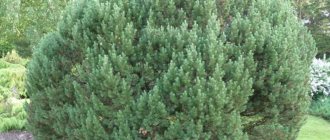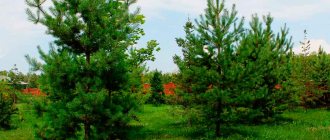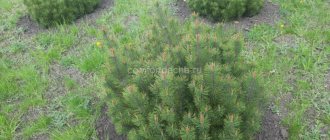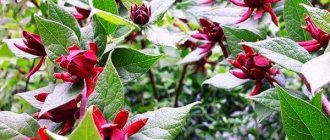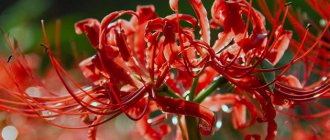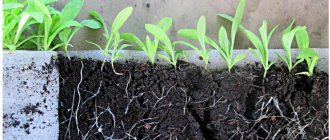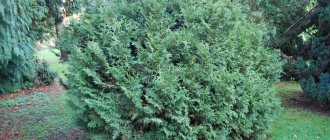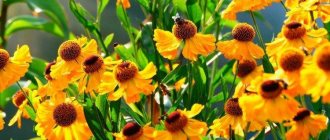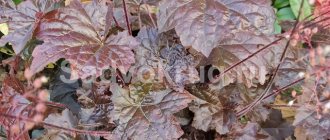18454
When landscaping plots, gardeners often give preference to low-growing pine, fir, cypress, cereals and flowering crops. Miniature coniferous plantings do not require much space, withstand unfavorable conditions well, are rarely susceptible to disease, and serve as an ideal backdrop for flowers.
Pine among the stones
Description of the plant
Mountain pine is an evergreen multi-stemmed shrub that reaches up to 5 meters in height. The shoots of the plant are short, spreading, and slightly curved upward. The highly branched root system is located superficially, and this must be taken into account when loosening the soil. Coniferous needles are small, 4-6 cm in length, painted in a dark olive color. Cones begin to form from the age of six.
Dwarf pine is indispensable in landscape design. Has a number of advantages:
- frost resistance and drought resistance;
- thanks to its strong rhizome, it withstands gusty winds;
- pine is unpretentious to the composition of the soil;
- responds well to crown formation;
- has strong immunity to diseases;
- with good care, life expectancy is up to 1000 years.
Thuya Danika
Thuja Danika owes its unusual beauty to its slender trunk and small leaves of bright green color. The plant is used for alleys and hedges. You can plant a thuja in a rock garden, and it will become a color accent to any composition of subdued tones.
The shrub reaches a height of 80 cm, and the diameter of the crown is about a meter. Danica does not grow particularly quickly, which is quite convenient for a small area. Its needles do not require special care. An interesting feature: the leaf cover of the bush changes color in the cold season, becoming almost brown.
Thuja Danica is frost-resistant and grows well in poor soils. It is better to fertilize the soil before planting, and lighten heavy soil by adding drainage materials.
Selection of variety and seedlings
Dwarf . The shrub is low growing, growing up to 1.5 meters in height. It has a ball-shaped crown formed from dark olive needles. Looks ideal both in single and joint plantings on lawns and rocky gardens.
Mini Pug . The plant of this species has a cushion shape with dark green needle-like needles. The pine is dwarf, reaching a height of up to 60 cm. It grows well in partial shade and is an indispensable addition when designing rocky gardens.
Columnaris . Tall variety of mountain pine. An adult plant reaches up to 3 meters in height. The crown is narrow-conical, up to 3 meters in diameter.
Winter Gold . The pine is small, up to half a meter in height and a meter in diameter, and forms a dense spherical crown. The variety has the ability to change the color of its needles: in summer - light olive, in winter - bright golden.
Cockade . An exotic variety that has yellow stripes on the needles, reminiscent of dragon eyes.
Ophir . Popular due to the shape of the crown, reminiscent of a pin. If the plant is grown in a lighted place, the color of the needles will be light yellow; in the shade, the needles will become dark green.
It is necessary to select only healthy seedlings for planting. A healthy plant is brightly colored; the tips of the needles should not be dried out or yellowed. For better survival, shrubs must be purchased with a closed root system.
For planting, purchase a young plant, the age of which should not exceed five years.
It is better to purchase seedlings from trusted suppliers, greenhouses or nurseries, as this increases the chance of purchasing a healthy plant tenfold.
Fir Icebricker
Icebreaker fir is a relatively new variety. The crown of the tree grows up to 1.2 m in width and resembles a lush volumetric pillow. At the same time, the height of the conifer is only 0.8 m. Sometimes leading shoots appear on mature trees, which form a multi-stemmed crown.
The fir needles are rich green, and the bottom has a silvery-white hue, soft to the touch. Its beams are twisted in such a way that the lower surface becomes immediately visible to the observer. This coloring does not go unnoticed by landscape designers: fir is gladly used in rockery compositions and in open areas next to low perennials.
Planting a mountain pine
The growth and development of the plant depends on the choice of location and soil preparation. A properly prepared site is the key to successful growth.
Place, soil, scheme and timing
Dwarf pine is a light-loving plant and grows on almost any soil. Therefore, you need to choose a well-lit place. The soil should be low acidity. To obtain a decorative appearance, it is better to plant pine on sandy or sandy loam soil. If the soil contains a lot of sand, it must be diluted with clay.
The best time to plant mountain pine is considered to be early spring (April-May) or autumn (early September).
Before planting a mountain pine, it is necessary to properly prepare the hole. To do this, dig a hole a meter deep and line the bottom with compost, manure or nitrogenous fertilizers. Seedlings with a lump of earth are carefully placed in a prepared place and covered with earth, making sure that the root collar remains above the surface of the earth. The soil is thoroughly compacted, watered and mulched.
If more than one plant is planted, they must be placed at a distance of 2 meters from each other.
Caring for young seedlings consists of sheltering them from the sun and timely watering as the top layer of soil dries out, for 2-3 weeks. A young plant tolerates replanting much better and takes root faster, therefore, for this you need to purchase five-year-old seedlings.
Gardening tips
Selivanova Elena Vasilievna, 32 years old, St. Petersburg
Many years ago I planted a mountain pine tree on the property. The plant is over 10 years old. I formed the tree so that it would grow on a trunk. The pine reached a height of 0.7 m and a girth of about 1 m. I have the Ophir variety of Polish selection. In summer the needles are green, in winter they turn yellowish. In addition to pruning, I also tie the plant to a support. Otherwise the dwarf is unpretentious. To avoid diseases, I spray it with fungicides twice a year.
Tronov Ivan Vladimirovich, 57 years old, Ryazan
Two varieties grow at the dacha: Gnome and Mugus. Externally they are very similar, differing only in dimensions. The gnome is the shortest, no more than 1 m high. When choosing hybrids, I took into account their unpretentiousness. I don’t consider capricious plants that need to be constantly covered or sprayed. Dwarf pine has good winter hardiness. To grow it, good soil moisture is required, since the roots of the plant do not reach the deep layers of the soil.
Mountain pine care
Mountain pine is an unpretentious plant. For growth and development, it needs to create favorable conditions.
Watering and fertilizing. Dwarf pine is drought-resistant and does not require additional watering. The exception is the Rumelian pine variety. This variety is moisture-loving and requires watering three times a season in the amount of two buckets per plant.
Feeding is applied to young shrubs in the first two years of growth. Rules for feeding and fertilizing:
- nitrogen fertilizers are applied to the planting hole;
- In spring, only complex fertilizers are used;
- in the autumn, the plant cannot be fertilized, since the young plant will not survive wintering well;
- After two years, the plant does not need to be fertilized, since it will receive the nutrients that accumulate in the coniferous litter.
Pruning and shelter for the winter . Most pine varieties form their crown on their own, and therefore do not need additional pruning. Pruning is carried out only to prevent the disease, removing old, frozen and damaged branches.
To create a lush crown in the spring, carefully pinch off young shoots by ⅓. Thus, the crown of the bush will become much thicker, and the branches will slow down their growth.
Dwarf pine can withstand severe frosts, but to preserve young seedlings it is better to cover them. This procedure is done in order to protect the plant from sunburn. Spruce branches or special breathable covers are ideal for this purpose.
Reproduction and growth
Pine is propagated by seeds, cuttings and grafting. The simplest method is considered to be propagation by seeds. Reproduction by cuttings and grafting is considered an insufficiently effective method and can only be done by specialists.
Seed method
When propagated by seed, the shrub completely retains its decorative properties. This method is simple, and even novice gardeners can handle it. Seed propagation process:
- If seeds are sown at home, they must undergo stratification for 1.5–3 months. Seeds planted in open ground do not need stratification.
- Planting is carried out in spring in prepared seedling boxes.
- The substrate is light, nutritious and disinfected, sprinkled with peat on top to prevent fungal diseases.
- Stratified seeds are disinfected and planted in prepared soil at a distance of 5 cm from each other.
- The container is covered with polyethylene to create a favorable microclimate.
- After the shoots emerge, this takes about a month, the covering material is removed, and the container is moved to a warm, lighted place.
- Caring for seedlings involves timely watering.
- Plant strengthened seedlings in open ground a year after rooting. The best time for planting is early spring.
Flaws
Dwarf conifers have many advantages, but, unfortunately, there are also disadvantages:
- If there is heavy wet snow, the crown may be damaged or branches may break. To avoid this trouble, it is recommended to tie the conifers with soft ropes.
- Conifers are susceptible to fungal diseases. This happens especially often during damp, mild winters. You can fight this scourge with the help of special fungicidal preparations.
- Coniferous plants can get burned in the bright spring sun.
- Many conifers are very difficult to reproduce by seeds and cuttings.
- It is preferable not to try to propagate coniferous plants by seeds, but to buy a seedling from a nursery.
Diseases and pests
Coniferous plants have strong immunity to many diseases . But there are cases when the disease affects young, immature seedlings. This happens from improper care, after winter or after a rainy summer.
Schutte . Fungal disease. Recognizing the disease is not difficult: the needles turn dark red with black dots, the branches dry out, and a thin cobweb appears on the plant. Treatment consists of treating the plant with Bordeaux mixture and removing damaged branches. For prevention, the bush is treated with a copper-containing solution or horn.
Scleroderriosis . A common disease that affects coniferous plants. As a result of the disease, first the apical buds begin to die, and then all the branches. The spread of the disease can only be prevented by timely removal of the affected branches.
Aphid . Mountain pine is often affected by aphids. To combat it, chemical and biological products are used.
Planting coniferous plants and caring for them is not a very labor-intensive task and does not take much time. This shrub fits harmoniously into any corner of the garden: it decorates alpine hills, rocky gardens, and thanks to its shallow root system it is able to strengthen the slopes of reservoirs.
Dwarf conifers in landscape design
In modern gardening, dwarf coniferous trees are experiencing the peak of their popularity. They are a decoration for any garden plot. There are connoisseurs who collect entire collections of dwarf fir, spruce, pine and other representatives of the species.
The most successful people in growing small coniferous trees are in Holland. They offer a conditional classification of conifers:
- full-grown - growth is up to 30 cm per year, at the age of 10 years such coniferous crops reach a height of 3 m;
- medium-sized (semi-dwarf) - their size ranges from 15 to 30 cm;
- dwarf - no higher than 15 cm;
- mini-dwarf - up to 10 cm;
- microdwarf - no more than 5 cm.
Small conifers are used almost everywhere: single or group plantings, flower beds, containers. They are often located at the entrance to the house. Dwarf coniferous plants for the garden will attract attention in any type of landscape.
Advice! When purchasing small forms of trees, you need to carefully study the name - the form nana, dwarf or prostrata should be written on the label.
Experienced gardeners can determine at first glance how much a dwarf tree can grow, which allows them to correctly place it on the site.
